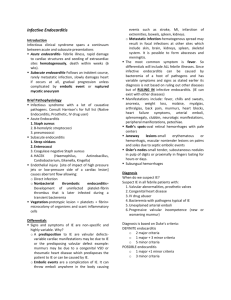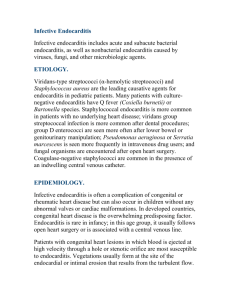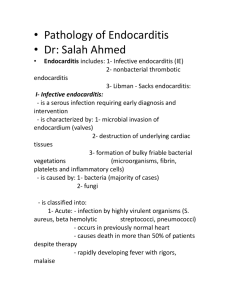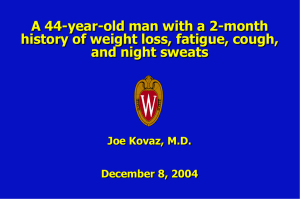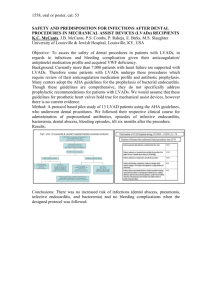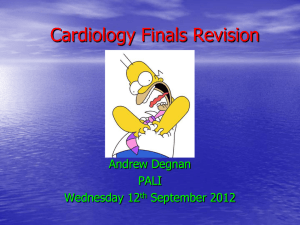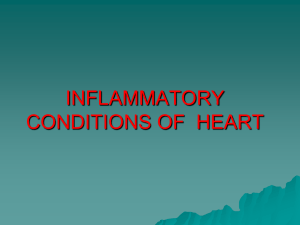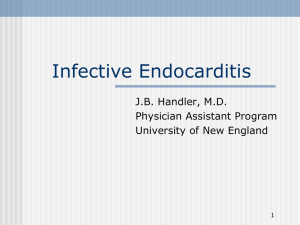Comprehensive Clinical Case Study
advertisement
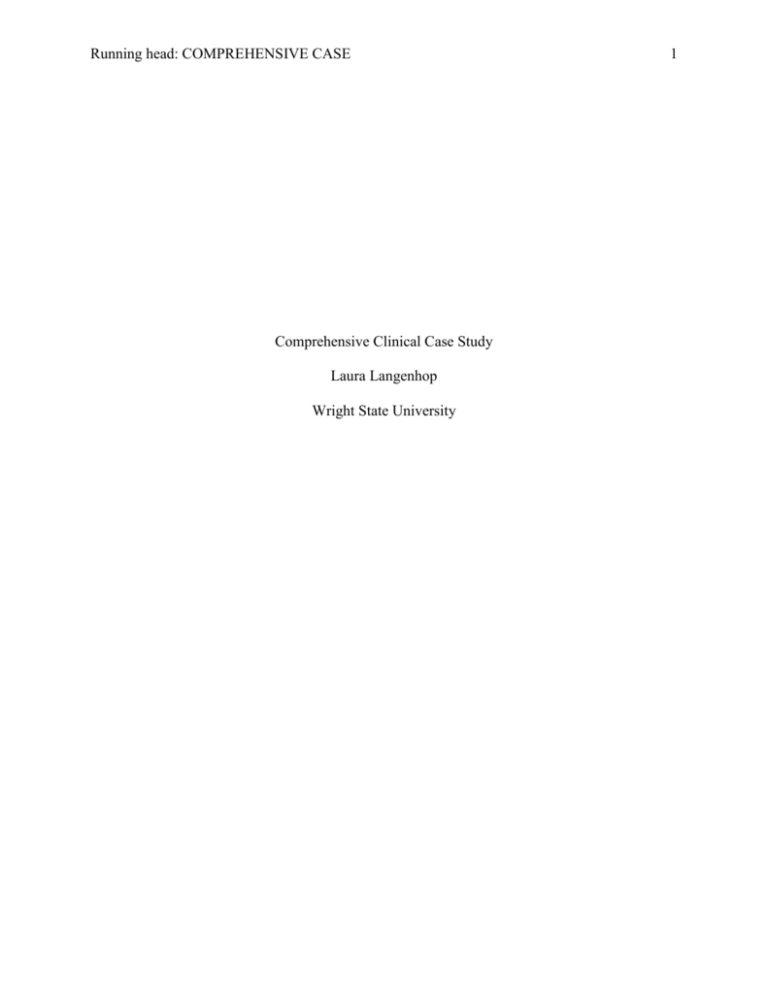
Running head: COMPREHENSIVE CASE
Comprehensive Clinical Case Study
Laura Langenhop
Wright State University
1
COMPREHENSIVE CASE
2
Comprehensive Clinical Case Study
Patient Information
R.D. is a 21 year-old Caucasian male
Source
Patient
Chief Complaint
Diarrhea, vomiting, chest pain, and shortness of breath for three days
History of Present Illness
R. D. is a 21 year-old male seen on hospital day 1 by the cardiac critical care service.
R.D. presented today with vomiting, diarrhea, chest pain, myalgia, and shortness of breath that
began three days ago. The patient stated he was eating pizza and afterwards became sick,
believing the symptoms to be related to the food ingested. Since then, the patient has continued
to experience myalgia, shortness of breath, and chest pain. The chest pain is pleuritic in nature
and worse on palpation of the anterior wall. The patient has rated the chest pain as a 5/10. The
patient has not tried any over-the-counter medications to alleviate the pain. Taking in deep
breaths makes the chest pain worse according to the patient. The patient is also a known
intravenous drug user (IDU) and he reported having emergency services called to his home two
weeks ago following a heroin overdose. According to previous records, the patient required two
doses of Narcan at the time of the overdose by an emergency medical technician (EMT). In the
emergency room, the patient had a bedside abdominal ultrasound that revealed no evidence of
gallstones or hepatomegaly. There was splenomegaly found on the ultrasound. Upon his arrival
to the ICU, the patient was given Phenylephrine for hypotension, along with a 500 mL Lactated
Ringer (LR) intravenous bolus. The patient had two peripheral blood cultures drawn and was
COMPREHENSIVE CASE
3
started on prophylactic antibiotics. The patient was ordered a transthoracic echocardiogram that
revealed evidence of vegetation on the tricuspid valve, the right atrium, raising concern for the
possibility of an infected automatic implanted cardiac defibrillator (AICD) and pacemaker.
Medical History
Hypertrophic Obstructive Cardiomyopathy (HOCM)
Depression
Surgical History
Pacemaker/AICD implantation in 2010
Inner ear surgery: Tube to right inner ear in 2000
Family History
Father: N/A (not present)
Mother: Alive. The mother has no current medical issues
Siblings: None
Social History
Cigarettes: 0.5 packs daily over the last three years
Recreational Drugs: Patient uses marijuana daily. The patient also uses heroin on occasion. The
patient states that the heroin used two weeks ago was the first in six months.
Allergies
No known drug allergies
Home Medications
Seroquel 400 mg by mouth at bedtime
Mirtazapine 15 mg by mouth at bedtime
Verapamil 20 mg by mouth BID
COMPREHENSIVE CASE
Oxycodone-Acetaminophen 5-325 mg one tablet by mouth Q6 hours PRN
Current Medications
Phenylephrine gtt infusing @ 100 mcg/min
Lactated Ringers infusing @ 125 mL/hr
Vancomycin intravenous 1 gram Q8 hours
Heparin subcutaneous 5,000 units Q8 hours
Pantoprazole 40 mg by mouth daily
Potassium chloride intravenous supplementation per replacement protocol
Magnesium sulfate intravenous supplementation per replacement protocol
Seroquel 400 mg by mouth
Review of Systems (ROS)
(At time of Admission)
General:
The patient reports fatigue, malaise and fever. The patient denies experiencing
chills, night-sweats, or sleep disturbances.
Neurological: Patient denies dizziness, syncope, or headache. Patient denies confusion, speech
problems, visual changes, or memory loss.
HEENT:
Patient denies visual changes, a sore throat, a cough, hearing loss, problems with
speech, or nasal drainage.
Neck:
Patient denies lymphadenopathy or tenderness of the neck.
Respiratory:
Patient presents with dyspnea reported as pleuritic and worse on inspiration.
Patient denies hemoptysis, wheezing, or orthopnea. Patient denies any sputum
production.
4
COMPREHENSIVE CASE
CV:
Patient complains of pleuritic chest pain as described above. Patient denies
palpitations, syncope, or tachycardia.
Abdomen:
Patient complains of experiencing nausea, vomiting, and diarrhea over the last
couple of days. Patient denies having a difficult time eating, chewing, drinking,
or swallowing. The patient states he has lost weight unintentionally due to the
vomiting and diarrhea of the last several days.
GU:
Patient denies change in urinary frequency, urgency, or dysuria.
M/S:
Patient denies joint pain, joint swelling, or muscle pain. The patient denies
problems with ambulating or problems with fine motor skills.
Skin:
Patient denies ecchymosis, lesions, or trauma to the skin.
Psychosocial: The patient does have a history of depression and takes medication at home.
Currently, the patient feels anxious.
Physical Exam
Vital Signs:
Temperature 102.5 degrees
Blood Pressure 78/54 on arrival to the CVICU and 107/64 via arterial line (on
Phenylephrine)
RR 32
HR 100 bpm
SpO2 100%
General:
This is a 21 year-old Caucasian male resting in bed in NAD.
Neurological: Patient is able to follow commands. Patient has intact cranial nerves II-VII.
5
COMPREHENSIVE CASE
HEENT:
6
The patient’s skull is normocephalic and a-traumatic. There are no masses or
lesions palpated. The patient’s sclera are white. Conjunctiva are pink. PERRL
@ 3mm. The patient is without nystagmus, hemorrhages, or exudates. Tympanic
membranes are pearly grey bilaterally without erythema. Nasal mucosa is pink
and moist and septum is midline. Oral mucosa is pink, moist, and without
erythema.
Neck:
The patient’s trachea is midline. The patient is without lymphadenopathy. The
neck is supple. JVD notes at 8 cm H20 on examination.
CV:
Patient presents with a normal heart rate and regular rhythm. The patient has an
S1 and S2. An S3 is heard at the second intercostal space right sternal border. An
S4 is heard at the fifth intercostal space mid-clavicular line. The patient is
positive for Carvello’s sign. Brisk carotid upstrokes without bruits are noted.
The PMI is located at the fifth intercostal space eight centimeters lateral to the
mid-sternal line.
Respiratory:
Patient presents with equal air entry. Lung expansion is equal. Patient presents
with noted tachypnea. Patient is without retractions, wheezing, or rhonchi.
Patient presents with rales in bilateral lower lobes. There is dullness to percussion
to both lower lobes of the lung fields. Patient is negative for tactile fremitus.
Abdomen:
The abdomen is soft and non-distended. Bowel sounds are active throughout all
quadrants. The patient is negative for mass upon light, moderate, and deep
palpation. The patient is negative for costo-vertebral tenderness. The patient is
negative for hepatomegaly or splenomegaly on physical examination.
COMPREHENSIVE CASE
G/U:
7
The patient is voiding clear/yellow urine from a Foley catheter. There is no
penile discharge.
M/S:
The patient has full range of motion in all extremities with 2+ reflexes and is
symmetric.
Extremities:
Peripheral pulses are 2+ and normal. No pedal edema is present. No clubbing or
cyanosis is noted. The patient’s capillary refill is less than three seconds.
Skin:
Skin is warm and dry. Coloration is normal for ethnicity. Nails are without
cyanosis or clubbing.
Laboratory Findings:
Table 1: Complete White Blood Cell count and Renal Panel
Complete
Blood Cell
Count
(CBC)
WBC
Results
Normal
Values
Renal Panel
Results
Normal
Values
15
Sodium
133
RBC
4.68
Potassium
3.8
Hemoglobin
13.7
Chloride
101
Hematocrit
38.4
3.8-10.8 K
cells/mL
3.8-5.1 M
cells/mL
11.7-15.5
g/dL
35-40%
CO2
21
MCV
82.1
80-100 fL
BUN
14
135-146
mmol/L
3.5-5.3
mmol/L
98-110
mmol/L
21-23
mmol/L
7-25 mg/dL
MCH
29.2
Creatinine
0.77
0.5-1.2 mg/dL
MCHC
34.2
27-33
pg/cell
32-36 g/dL
Glucose
100
65-99 mg/dL
RDW
12.8
11-15%
Calcium
8.5
Platelet
63
140-400 K/uL
Phosphorous
1.6
8.6-10.2
mg/dL
2.5-4.5 mg/dL
MPV
12.3
7.5-11.5 fL
Magnesium
1.6
1.5-2.5 mg/dL
Anion Gap
11
8-16 mEg/L
COMPREHENSIVE CASE
8
Albumin
3.7 g/dL
3.6-5.1 g/dL
Table 1 normal diagnostic values adapted from (Gomella, 2007) Clinician’s pocket reference
11th edition. Garden Grove, CA: McGraw Hill
Table 2. Arterial Blood Gas and Coagulation studies
Arterial Blood Gas
Results
Coagulation
Results
7.46
Normal
Values
7.35-7.45
pH
Normal
Values
12-13
seconds
PT
13.9
pCO2
34
35-45
INR
1.1
0.8-1.2
pO2
78
80-100
mmHg
PTT
27.1
30-50
seconds
HCO3
24
Fibrinogen
CO2 Content
23
BNP
455
mg/dL
2840
120-360
mg/dL
<100
Base Excess
-3
22-26
mmol/L
23-27
mmol/L
-2 to 2
Lactic Acid
1.6
0.5-2.2
Carboxyhemoglobin
0.2
Unknown
AST
31 U/L
0-35 U/L
Methoglobin
0.1
0-1.5 %
ALT
39 U/L
0-35 U/L
Reduced
Hemoglobin
% Hemoglobin
1
0-5 %
CRP
27.2
<0.3
96
95-98 %
Troponin 1
0.21
0-0.1 ng/mL
CK
36 mU/L
25-145
mU/L
0.3-1.1
mg/dL
<0.2 mg/dL
2.2 mg/dL
Total
Bilirubin
1.2 mg/dL
Direct
Bilirubin
0.7 mg/dL <0.8 mg/dL
Indirect
Bilirubin
Table 2 normal diagnostic values adapted from (Gomella, 2007) Clinician’s pocket reference
11th edition. Garden Grove, CA: McGraw Hill
COMPREHENSIVE CASE
9
Diagnostic Findings
Initial blood cultures drawn peripherally revealed gram-positive rods with a final culture
noted as methicillin resistant staphylococcus aureus (MRSA). The chest radiograph completed
on admission to the CVICU determined the patient as having bilateral airspace disease with
noted pulmonary edema in the bilateral lower lobes. A computed tomography (CT) scan of the
chest revealed mild pulmonary congestion without pleural effusion or pneumothorax. The
cardiomediastinal silhouette was unchanged from a previous exam in 2011. There were no other
abnormalities seen. An EKG on admission revealed the patient to be in normal sinus rhythm
without ST-elevation. The EKG also revealed that the patient has left ventricular hypertrophy
and Q-waves of <40 ms in leads V5, V6, AVL, and lead one.
On admission to the CVICU, the patient had a transthoracic echocardiogram (TTE). The
aortic valve was without sign of vegetation, but did have trivial regurgitation. The mitral valve
was without vegetation, but there did appear to be a ruptured chordae that moved vigorously as
related to the systolic motion of the mitral apparatus. The left atrium was without thrombus.
The right atrium revealed large highly mobile vegetation from the superior vena cava (SVC) and
right atrium (RA) junction that extended to the right atrial cavity. The tricuspid valve showed
evidence of vegetation and thickness to the anterior leaflet. There was moderate tricuspid valve
insufficiency seen on the echocardiogram. The pulmonic valve was without vegetation or
concern for valve dysfunction.
Differential Diagnosis
The differential diagnoses for this patient are endocarditis related to IDU, a pulmonary
embolism, cholecystitis, pneumonia, and myocardial infarction. The first differential diagnosis
is infective endocarditis due to IDU. Infective endocarditis is infection of endovascular
COMPREHENSIVE CASE
10
structures of the heart (Nishimura et al., 2014). The populations in which endocarditis can be
seen are the elderly, IDU’s, patients with prosthetic valves, and patients with congenital
anomalies (Nishimura et al., 2014). The most common organisms associated with infective
endocarditis are staphylococcus and streptococci (Nishimura et al., 2014).
The patient is febrile, has growth of MRSA on blood cultures, has vegetation on the
tricuspid valve and RA, and has a recent history of IDU. The patient’s C-reactive protein (CRP)
and fibrinogen are also elevated leading to the finding of an inflammatory response (Baynes &
Dominiczak, 2014). All findings listed are major and minor criteria of the Duke Criteria
(Baddour et al., 2005). The Duke Criteria was created in 1994 to classify patients with probable
infected endocarditis. Bacteremia with a known organism and echocardiography are two major
criteria in diagnosing infective endocarditis (Baddour et al., 2005). The patient’s fever, chest
pain, and history of IDU are minor criteria for diagnosing infective endocarditis (Baddour et al.,
2005).
The major risk factor for this patient in acquiring endocarditis is his known IDU.
Seventy percent of patients with endocarditis related to IDU show growth of MRSA on their
blood cultures (Nishimura et al., 2014). In a patient with endocarditis related to IDU, the classic
valve involved is the tricuspid valve. The pulmonic valve is usually not involved due to a lower
pressure gradient (Nishimura et al., 2014). The left sided heart valves (i.e. mitral and aortic) are
involved 40% of the time. In this specific case, only the tricuspid valve and RA show
vegetation. Normally, valve endothelium is immune to circulating bacteria. When endothelium
is disrupted, there is exposure of the underlying matrix proteins, tissue factor, platelets, and fibrin
(Habib et al., 2009). The exposure allows for bacteria to colonize causing infective endocarditis
(Habib et al., 2009).
COMPREHENSIVE CASE
11
The second differential diagnosis is pulmonary embolism (PE). The diagnosis of PE
alone is unlikely primarily because the patient presented with a fever and vegetation was found
on the echocardiogram. Suspicion of a PE is based upon the patient’s symptoms of chest pain,
shortness of breath, and young age (Saha & Rao, 2014). Since the patient is likely to have
infective endocarditis involving the tricuspid valve due to IDU, the ACNP should remain
concerned for risk of septic emboli (Baddour et al., 2005). Septic embolization can occur prior
to the start of anti-microbial therapy and can pose a risk during the first month of therapy
(Baddour et al., 2005). To rule out the diagnosis of a septic PE, the ACNP must order a
computed tomography (CT) scan (Saha & Rao, 2014).
The third differential diagnosis is acute cholecystitis. Cholecystitis is sudden
inflammation of the gallbladder (Welch, Chukwumah, Bowens, Arnell, & Ferri, 2011). This
inflammation can cause epigastric pain, sometimes described as chest pain. The patient’s first
symptoms were nausea and vomiting. Leukocytosis and a fever are typically present in a patient
with choleycystitis (Welch et al., 2011). Patients may have either calculous (with gallstones) or
acalculous (without stones) cholecystitis (Welch et al., 2011). The patient stated that he was
eating a pizza before his symptoms began, which poses the possibility of a gastrointestinal
problem. The patient however has a negative abdominal ultrasound and no history of having gall
bladder problem. The patient does not have abdominal pain specific to the right upper quadrant
and does not have a positive Murphy’s sign. These findings along with the TEE report suggest
another etiology (Welch et al., 2011).
The next differential diagnosis is pneumonia. Symptomology of pneumonia includes
chest pain, shortness of breath, and fever (Godara, Hirbe, Nassif, Otepka, & Rosenstock, 2014).
Due to the patient’s age and onset of symptoms, the pneumonia would be considered atypical.
COMPREHENSIVE CASE
12
Atypical pneumonia is of the mycoplasma, chlamydia, and legionella species. Other signs and
symptoms for pneumonia are a productive cough, coarse chest crackles, and bronchial breath
sounds (Godara et al., 2014). Though the patient has chest pain, shortness of breath, and fever,
he does not have sputum production and his chest radiograph was negative for atelectasis. Also,
the patient’s chest pain and shortness of breath most likely are related to HOCM and to the
patient’s probable endocarditis (Godara et al., 2014).
The last differential diagnosis would be a non-ST segment elevated myocardial
infarction. A myocardial infarction results from lack of blood and oxygen supply in the
myocardium (Chyu & Shah, 2014). The lack of blood supply and increase in oxygen demand are
a result of a ruptured atherosclerotic plaque. This patient’s risk factors for developing an MI
include his history of IDU, his daily cigarette smoking, and his history of HOCM. The patient
has no other typical risk factors such s coronary artery disease, obesity, and hypertension (Chyu
& Shah, 2014). Patients typically report chest pain that can radiate, shortness of breath, and
diaphoresis. Chest pain usually lasts 15-30 minutes, but may last longer (Chyu & Shah, 2014).
If the patient does not have chest pain on physical examination, the assessment may be
completely normal. In the presence of chest pain, the patient may have an S3 or S4 heart tone,
rales noted from left ventricular failure, and the patient may be visibly short of breath (Chyu &
Shah, 2014).
Electrocardiogram (ECG) findings in a patient with a myocardial infarction reveal Twave inversion or depression, ST changes, and may possibly show left ventricular hypertrophy.
Patients with a NSTEMI will also have elevated cardiac biomarkers (i.e. Troponin, CKMB,
BNP, CRP) without the presence of Q-waves on the EKG (Chyu & Shah, 2014). The patient in
this case has a mildly elevated Troponin, a normal CKMB, and an elevated BNP, Fibrinogen,
COMPREHENSIVE CASE
13
and CRP. The patient does have Q-waves <40 ms in the septal leads, but the most likely
rationale for this finding is the patient’s septal hypertrophy related to HOCM (Baddour et al.,
2005). Though one cannot fully exclude unstable angina, it is most unlikely. However the
patient’s increased inflammatory markers are related to infective endocarditis and the physical
examination findings are related to his existing HOCM diagnosis. The patient should have serial
Troponin-1 levels drawn to exclude the diagnosis of a NSTEMI (Chyu & Shah, 2014).
Diagnostic Tests and Rationale
CT of Chest
A computed tomography (CT) scan of the chest is a key diagnostic test in the health
management of this patient. A chest CT will not diagnose infective endocarditis as blood
cultures, echocardiography, and symptoms will. A CT scan will, however, help in diagnosing
any septic emboli that have traveled in the lungs. The patient presented to the hospital with chest
pain and shortness of breath. When a patient has shortness of breath in conjunction with
infective endocarditis, it is recommended to gather a chest CT to rule-out emboli (Baddour et al.,
2005). A spiral CT scan is completed during a single held breath in order to eliminate artifact.
A spiral CT has prominent vascular opacification (Saha & Rao, 2014). A better visualization is
seen with the use of intravenous contrast, though in some patients this may not be possible due to
renal function. The chest CT has a sensitivity of 83% and specificity of 96% with a positive
predictive value of 96% (Saha & Rao, 2014).
CT of the Abdomen
As noted, a CT of the abdomen or chest would not diagnose infective endocarditis in
patients. However, a CT is used to rule out embolization due to the vegetation found on the
echocardiogram. Patients with suspected infective endocarditis are also at risk for a splenic
COMPREHENSIVE CASE
14
infarction or abscess (Baddour et al., 2005). The infarction and abscess formation are related to
septic embolization of bacteria traveling to the spleen. The majority of splenic infarction and
abscess formations originates from left sided endocarditis. Though splenomegaly is typically
seen in 30% of the cases, splenomegaly may not be present. A CT of the abdomen has a 90-95%
sensitivity and specificity for diagnosing a splenic infarction and abscess (Baddour et al., 2005).
Transthoracic Echocardiogram (TTE) & Trans-esophageal Echocardiogram (TEE)
With a patient suspected of having infective endocarditis, the ACNP has to visually
assess an echocardiogram. When suspicion of infective endocarditis remains low, a TTE is
typically completed first. However, when the TTE is negative for signs of endocarditis, but
suspicion remains high, a TEE is recommended (Baddour et al., 2005). The American College of
Cardiology recommends a TEE for viewing vegetation and valve abnormalities as opposed to a
transthoracic echocardiogram (Baddour et al., 2005). There are three findings on an
echocardiogram that suggest infective endocarditis: valvular vegetation, abscess, and dehiscence
(Gersch et al., 2011). The TTE has a sensitivity of 40-63% whereas a TEE has a sensitivity of
90-100% (Gersch et al., 2011). False negatives may appear in the presence of vegetation too
small to see on the echocardiogram. False positives can occur when there are valvular
abnormalities suspected from endocarditis (Baddour et al. 2005). It is a Class one, Level A
recommendation that patients with an original positive transthoracic echocardiogram have a
trans-esophageal echocardiogram if suspicion for infective endocarditis and cardiac compromise
remains high (Baddour et al., 2005).
Aerobic and Anaerobic Blood Cultures
In diagnosing a patient with infected endocarditis, one of the most substantial tests is the
blood culture. Prior to starting antibiotic therapy for this patient, three sets of blood cultures
COMPREHENSIVE CASE
15
should be obtained (Owens and Fowler, 2012). To avoid contamination, two separate sites
should be used with peripheral draws recommended. Serial draws during antibiotic therapy are
recommended in order to detect the eradication of the organism. Up to 50% of blood cultures are
falsely positive in results while five percent report as falsely negative (Owens & Fowler 2012).
The false-positive blood cultures can depend on the virulence of the organism. Growth of
MRSA is always significant, where growth of coagulase negative staphylococci is typically
considered contaminated (Owens & Fowler, 2012).
Culture negative infective endocarditis is seen in 2.5-30% of patients with infective
endocarditis (Gersh et al., 2011). Organisms that may cause culture negative endocarditis
include Brucella species, Coxiella Burnetii, Bartonella species, Tropheryma Whipplei,
Mycoplasma species, and Legionella species (Gersh et al., 2011). In patients with suspected
endocarditis and negative blood cultures, the need for additional microbiology, such as growth of
uncommon microbials on a chocolate agar plate, may be warranted (Gersh et al., 2011).
Treatment of patients should not be delayed even when blood cultures remain negative (Baddour
et al., 2005).
Abdominal Ultrasound
The patient presented to the emergency department with a three-day history of nausea,
vomiting, and diarrhea. The patient also had chest pain, fever, and slightly elevated bilirubin
levels associated with the nausea and vomiting. Along with the TTE, the patient also should
have an abdominal ultrasound to rule out gall bladder disease (Carey, Arnell, Lee, & Scherger,
2011). The initial test of choice for ruling out gall bladder disease is the abdominal ultrasound
(Carey et al., 2011). The abdominal ultrasound has a sensitivity of 95% and a specificity of 90%
in detecting biliary sludge and gallstones (Carey et al., 2011). False positives occur from artifact
COMPREHENSIVE CASE
16
from distended bowel loops and calcium bile salt precipitates (Carey et al., 2011). False
negatives occur from gallstones that are too small to see on an ultrasound (Carey et al. 2011).
The patient did have normal liver function tests, but 10-15% of patients may have
choledocholithiasis in the absence of elevated liver enzymes (Carey et al., 2011). For this
reason, an abdominal ultrasound should be ordered.
Prioritized Plan
Treating a patient with infective endocarditis begins with treating the underlying cause.
The blood cultures drawn on admission revealed MRSA growth. Vancomycin is the medication
of choice in treatment of infective endocarditis with positive MRSA growth and is considered a
Level 1B recommendation (Baddour et al., 2005). The dosage recommended for the treatment of
infective endocarditis is 30mg/kg divided into two to three doses per day (Baddour et al., 2005).
In the state of Ohio the acute care nurse practitioner (ACNP) with a certificate to prescribe (CTP)
is able to prescribe Vancomycin per institutional standards (Ohio Board of Nursing, 2014).
The patient required insertion of a right intra-jugular line for monitoring central venous
pressure (CVP) and fluid status. The goal CVP for a patient with sepsis is between 8-12 mmHg
(Dellinger et al., 2012). The patient was started on a lactated ringer infusion at 125 mL/hr versus
normal saline to prevent hyperchloremic acidosis (Dellinger et al., 2012). The ACNP is careful
to monitor fluid status in this specific patient due to the fact that he has an increased risk of
becoming volume overloaded secondary to HOCM and the left ventricle’s inability to eject blood
from the outflow tract (Baddour et al. 2005). The patient initially presented with hypotension
most likely related to sepsis given the patient’s bacterial growth, temperature, tachycardia, and
known source of infection (Dellinger et al. 2012). The patient was started on a Phenylephrine
infusion, the vasopressor of choice for a hypotensive patient with HOCM who does not respond
COMPREHENSIVE CASE
17
to fluid resuscitation (Gersh et al., 2011). Phenylephrine is an alpha agonist producing systemic
vasoconstriction (Marino, 2014). By increasing afterload in a patient with HOCM, the coronary
arteries can be perfused. The goal mean arterial pressure for this patient is > 60 mmHg
(Baddour et al., 2005). In the state of Ohio, the ACNP with a CTP can prescribe Phenylephrine
(Ohio Board of Nursing, 2014).
The patient was ordered repeat blood work to monitor renal function and to trend the
complete blood cell count. The patient was also ordered mixed venous saturation every twelve
hours to view tissue oxygenation with a goal greater than 65% (Dellinger et al., 2012). A Foley
catheter was also placed to record and monitor urine output. The goal urine output for this
patient would be 0.5mL/kg/hr (Dellinger et al., 2012).
The AICD was shown on the CT scan of the chest to have a pocket of fluid, most likely
an abscess, surrounding the AICD wires. The patient was taken to the operating room to have
the AICD removed. The removal of the AICD eliminates one source of infection. In the
operating room, the patient received three liters of LR. On admittance back to the CVICU
following the operating room, the patient developed increased shortness of breath and agitation.
The patient was placed on a 15-liter non-rebreather mask for decreased oxygen saturations. An
arterial blood gas was performed and results include a pH of 7.50, PCO2 20, HCO3 21, PO2 66,
SpO2 of 84, and a lactate of 5.5. The chest radiograph revealed pulmonary edema. The patient
was intubated due to respiratory failure likely to flash pulmonary edema. The patient was also
febrile on admittance from the OR at 102.8 degrees Fahrenheit.
The patient was placed on pressure support ventilation with a PEEP of 6 and a pressure
support of 10. The patient was given 40 mg intravenous furosemide for flash pulmonary edema
per guideline recommendation (Hunt et al., 2009). A Fentanyl infusion was initiated for
COMPREHENSIVE CASE
18
discomfort related to the AICD extraction at a rate of 50 mcg/hr with an as needed Fentanyl
order for 50 mcg every two hours for increased agitation and sedation. The patient was also
placed on a Propofol infusion with titration orders 10-100 mcg/kg/min for a RASS of negative
two. The patient had a nasogastric tube placed for oral medication administration.
Acetaminophen was given for the patient’s fever. The Phenylephrine infusion will continue to
maintain a MAP greater than 60 mmHg. The patient was changed to a Normosol infusion at 100
mL/hr to maintain hemodynamic stability in light of the patient’s sepsis etiology and increased
lactate. In the state of Ohio, the ACNP with a CTP can prescribe Normosol, Fentanyl, and
Propofol per institutional standards (Ohio Board of Nursing, 2014).
The patient will remain on deep vein thrombosis (DVT) prophylaxis with 5,000 units of
Heparin administered subcutaneously every eight hours. The patient was started on peptic ulcer
prophylaxis with intravenous pantoprazole 40 mg daily. The patient will continue with the
intravenous Vancomycin for MRSA coverage and receive 650 mg of Acetaminophen via the NG
tube for the patient’s fever. In the state of Ohio, the ACNP with a CTP may prescribe Heparin,
Pantoprazole, lactated ringers, Acetaminophen and Phenylephrine (Ohio Board of Nursing).
Follow-up
The completion of antibiotic therapy depends on negative blood cultures results. Blood
cultures should be drawn every two to four days until negative. For this patient, once negative
blood cultures result, it is recommended continuing with four weeks of Vancomycin therapy
(Habib et al., 2009). Patients who have a diagnosis of infective endocarditis remain at a high risk
for relapse. It is a Class IIb, Level C recommendation to have a repeat transthoracic
echocardiogram following completion of treatment (Baddour et al., 2005).
COMPREHENSIVE CASE
19
Another issue that can occur during therapy is a fever that will not subside. Typically, a
patient can normalize the fever within five to ten days of treatment (Habib et al., 2009). A
persistent fever during therapy can mean inadequate antibiotics, resistance to antibiotics, infected
central lines, and spread of infection. In the event of a persistent fever, intravenous lines should
be changed and the patient should be re-cultured to look for new growth (Habib et al., 2009). An
echocardiogram should also be obtained in order to assess the patient’s valves and look for new
growth or abscesses (Habib et al., 2009). Finally, serial ECG’s should be performed in order to
assess conduction changes that can occur perivalvular abscesses (Baddour et al., 2005).
Patients with infective endocarditis may need valvular surgery depending on the course
of treatment and the function of the affected valve. In light of anti-microbial therapy, valvular
surgery may be warranted in the presence of heart failure caused by valvular insufficiency.
When there is valvular dehiscence, rupture, fistula, or perforation, or when there is a perivalvular
abscess seen on echocardiogram, there is Level B evidence for the replacement or repair of the
valve (Baddour et al., 2005). Valvular surgery is also recommended when persistent fever
occurs for more than a week within the use of a proper antibiotic regimen and when all other
rationale for fever has been excluded (Habib et al., 2009).
A patient’s systemic embolization is another concern for the ACNP. A patient, who has a
vegetation of greater than 10 mm in diameter, more commonly on the mitral valve, has an
increased risk for embolization. The decision to repair the affected valve is related to the
likelihood of system embolization (Baddour et al., 2005). The patient is also at risk for multiorgan system failure (Thuny, Grisoli, Collart, Habib, & Raoult, 2012). The ACNP needs to
follow daily laboratory work including a complete blood cell count, renal function, and arterial
blood gas (ABG). The ACNP should perform daily assessments on this patient and remain in
COMPREHENSIVE CASE
20
close communication with the nurses on any changes in the patient’s neurological, renal,
pulmonary, or cardiac status (Thuny et al., 2012).
Once he is stable, extubated, and can be managed in an outpatient setting, there is
consideration on how to deliver antibiotics to this patient who has a history of IDU. It is
recommended that a patient who is stable receive antibiotics via a peripherally inserted central
catheter (PICC) line (Baddour et al., 2005). Because this patient has a history of IDU, he cannot
go home because he poses a risk of injecting recreational medications into the PICC line. The
ACNP will need to work with the unit social worker or case manager to see if the patient can
either qualify for a short-term nursing facility or can enter into a drug and alcohol treatment
facility (Baddour et al., 2005; Godara et al., 2014). If there is a chance the patient can be
managed with an oral antibiotic, then the ACNP can attempt to send the patient home with a
responsible caregiver (Baddour et al., 2005).
Health Promotion Activities
It is very important to promote health and wellbeing to the patient. While the patient
remains intubated and sedated, the ACNP should promote health and wellbeing by ordering VAP
prevention including elevating the head of the bed 30 degrees and ordering mouth care to be
performed every four hours (Isakow & Kollef, 2012). The patient will be placed on peptic ulcer
prophylaxis while intubated and without enteral nutrition. Finally, the patient is ordered
subcutaneous Heparin and sequential compression devices to promote deep vein thrombosis
prophylaxis (Isakow & Kollef, 2012).
The ACNP will wean the ventilator setting as the patient tolerates. As fluid from the
pulmonary edema is removed from his lung, the patient’s lung compliance will increase, making
it easier to wean the ventilator and extubate him (Isakow & Kollef, 2012). Once extubated, the
COMPREHENSIVE CASE
21
patient will work with physical and occupational therapy to prevent deconditioning (Isakow &
Kollef, 2012).
Nutrition is also an important factor in the health of this patient. While the patient is
intubated, the patient should have a nasogastric tube placed in order to initiate trophic feeds. The
goal for this patient is to receive low dose feeding with 500 kcal per day following 48 hours of
the sepsis diagnosis (Dellinger et al., 2012). The low dose feeding will help with gut motility
and wound healing. The feeds will then be advanced as tolerated. The patient is a young
individual and the goal is to be extubated once the pulmonary edema subsides. Once the patient
is extubated, the patient should be able to have a normal diet and able to swallow appropriately
with protein supplementation as needed (Dellinger et al., 2012).
Currently the patient smokes cigarettes daily. It is important this patient receives
adequate smoking cessation education (National Guideline Clearinghouse [NGH], 2008). The
patient can be given options and explanations on how to quit cigarette usage. Cessation of
smoking is crucial for this patient, not just for this disease, but also to prevent other comorbidities in the future (NGH, 2008). Smoking is attributed to cancer, heart disease, and
pulmonary diseases such as emphysema and chronic obstructive pulmonary disease (NGH,
2008). It is the responsibility of the ACNP to educate the patient on the risks of smoking as well
as the benefits for quitting.
This patient has a history of IDU. When considering health promotion for this individual,
the ACNP begins with the root of the issue. The patient is a recreational heroin user who
recently suffered a heroin overdose. Admittance to an inpatient drug and alcohol rehabilitation
center is a valid suggestion (Baddour et al., 2005). Since the patient is at an increased risk for
acquiring endocarditis in the future, offering the patient an outlet to cease IDU activity is crucial.
COMPREHENSIVE CASE
22
Also, the patient is at an increased risk for death if he continues using heroin on a recreational
basis Godara et al., 2014). A thorough conversation with the patient and his support system
should be completed in order to promote future health (Baddour et al., 2005).
As noted, the patient is at risk for a reoccurrence of endocarditis. Serial echocardiograms
up to twelve months following the diagnosis are recommended in order to assess valve function
(Thuny et al., 2012). Education is necessary for patients regarding signs and symptoms of
recurrent endocarditis including fever, chest pain, shortness of breath, and malaise. Patients
should be educated on the importance of good oral hygiene in prevention of endocarditis (Thuny
et al., 2012). In patients with a history of endocarditis, all dental and cardiac procedures require
antibiotic prophylaxis in order to prevent infective endocarditis (Baddour et al., 2005). In
patients with infective endocarditis, teaching good hygiene and offering behavioral education
may decrease the risk of endocarditis and are paramount in disease prevention and in promoting
wellbeing (Baddour et al., 2005; Thuny et al., 2012).
COMPREHENSIVE CASE
23
References
Baddour, L. M., Wilson, W. R., Bayer, A. S., Fowler, V. G., Bolger, A. F., Levinson, M. E., ...
Taubert, K. A. (2005). Infective Endocarditis. Circulation, 111, 3167-3184.
http://dx.doi.org/10.1161/_CIRCULATIONAHA.105.165563
Baynes, J. W., & Dominiczak, M. H. (2014). Blood and plasma proteins. In Medical
Biochemistry (4th ed.). Retrieved from https://www-clinicalkeycom.ezproxy.libraries.wright.edu:8443/#!/ContentPlayerCtrl/doPlayContent/3-s2.0B978145574580700004X/{%22scope%22:%22all%22,%22query%22:%22Creactive%20protein%22}
Carey, W., Arnell, T., Lee, L., & Scherger, J. (2011, November 19). Cholelithiasis and
choledocholithiasis. First consult. Retrieved from https://www-clinicalkeycom.ezproxy.libraries.wright.edu:8443/#!/ContentPlayerCtrl/doPlayContent/21-s2.01014767/{%22scope%22:%22all%22,%22query%22:%22Ultrasonography%20of%20ab
domen%22}
Chyu, K. Y., & Shah, P. K. (2014). Unstable angina/non-ST elevation myocardial infarction. In
M. H. Crawford (Ed.), Current diagnosis & treatment cardiology (4th ed.). Retrieved
from
http://accessmedicine.mhmedical.com.ezproxy.libraries.wright.edu:2048/content.aspx?bo
okid=715&sectionid=48214538&Resultclick=2
Dellinger, R. P., Levy, M. M., Rhodes, A., Annane, D., Gerlach, H., Opal, S. M., ... Moreno, R.
(2012). Surviving Sepsis Campaign: International guidelines for management of severe
sepsis and septic shock: 2012. Retrieved from Surviving Sepsis Campaign:
http://www.sccm.org/Documents/SSC-Guidelines.pdf
COMPREHENSIVE CASE
24
Gersh, B. J., Phil, D., Maron, B. J., Bonow, R. O., Dearani, J. A., Fifer, M. A., ... Yancy, C. W.
(2011). 2011 ACCF/AHA guideline for the diagnosis and treatment of hypertrophic
cardiomyopathy. Journal of American College of Cardiology, 58(25), e212-e260.
http://dx.doi.org/10.1016/j.jacc.2011.06.011
Godara, H., Hirbe, A., Nassif, M., Otepka, H., & Rosenstock, A. (2014). The Washington
manual of medical therapies (34th ed.). Philadelphia, PA: Lippincott Williams &
Wilkins.
Gomella, L. G. (2007). Clinician’s pocket reference (11th ed.). Garden Grove, CA: McGraw
Hill.
Habib, G., Tornos, P., Thuny, F., Pendergrast, B., Vilacosta, I., Moreillon, P., ... Zamarono, J.
(2009). Guidelines on the prevention, diagnosis, and treatment of infective endocarditis
of the European society of cardiology. European Heart Jouranl, 30, 2369-2413.
http://dx.doi.org/10.1093/eurheartj/ehp285
Hunt, S. A., Abraham, W. T., Chin, M. H., Feldman, A. M., Francis, G. S., Ganiats, T. G., ...
Yancy, C. W. (2009). 2009 focused update incorporated into the ACC/AHA 2005
guidelines for the diagnosis and management of heart failure in adults: A report of the
american college of cardiology foundation/American heart association task force on
practice guidelines . Circulation, 119, e391-e479.
http://dx.doi.org/10.1161/CIRCULATIONAHA.109.192065
Kollef, M., & Isakow, W. (2012). The Washington manual of critical care (2nd ed.).
Philadelphia, PA: Lippincott Williams & Wilkins.
Marino, P. L. (2014). The ICU book (4th ed.). Philadelphia, PA: Lippincott Williams & Wilkins.
COMPREHENSIVE CASE
25
National Guideline Clearinghouse. (2008). Smoking cessation services in primary care,
pharmacies, local authorities and workplaces, particularly for manual working groups,
pregnant women and hard to reach communities. Retrieved from https://wwwclinicalkeycom.ezproxy.libraries.wright.edu:8443/#!/ContentPlayerCtrl/doPlayContent/31-s2.012286/{%22scope%22:%22all%22,%22query%22:%22smoking%20cessation%22}
Nishimura, R. A., Otto, C. M., Bonow, R. O., Carabello, B. A., Erwin, J. P., Guyton, R. A., ...
Thomas, J. D. (2014, March 3). 2014 ACC/AHA guideline for the management of
patients with valvular heart disease: a report of the American college of
cardiology/America heart association task force on practice guidelines. Circulation, 129,
2440-2492. http://dx.doi.org/10.1161/CIR.0000000000000031
Ohio Board of Nursing (2014). The formulary developed by the Committee on Prescriptive
Governance. Retrieved form
http://www.nursing.ohio.gov/PDFS/AdvPractice/Formulary_May-19-2014.pdf
Owens, T. A., & Fowler, V. G. (2012). Infective endocarditis. In S. C. McKean, J. J. Ross, D. D.
Dressler, D. J. Brotman, & J. S. Ginsberg (Eds.), Principles of practice and hospital
medicine). Retrieved from
http://accessmedicine.mhmedical.com.ezproxy.libraries.wright.edu:2048/content.aspx?bo
okid=496&sectionid=41304184&jumpsectionID=41319227&Resultclick=2
Saha, S. A., & Rao, R. K. (2014). Pulmonary embolic disease. In M. H. Crawford (Ed.), Current
diagnosis & treatment cardiology (4th ed.). Retrieved from
http://accessmedicine.mhmedical.com.ezproxy.libraries.wright.edu:2048/content.aspx?bo
okid=715&sectionid=48214563&jumpsectionID=48217987&Resultclick=2
COMPREHENSIVE CASE
26
Thuny, F., Grisoli, D., Collart, F., Habib, G., & Raoult, D. (2012, February 7). Management of
infective endocarditis: challenges and perspectives. Lancet, 379, 965-975.
http://dx.doi.org/10.1016/S0140-6736(11)60755-1
Welch, J. P., Chukwumah, C. V., Bowens, N., Arnell, T., & Ferri, F. F. (2011, August 31). Acute
cholecystitis. First Consult. Retrieved from https://www-clinicalkeycom.ezproxy.libraries.wright.edu:8443/#!/ContentPlayerCtrl/doPlayContent/21-s2.01016248/{%22scope%22:%22all%22,%22query%22:%22Cholecystitis%22}
